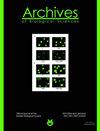塞尔维亚黄瓜花叶病毒亚群的RT-PCR-RFLP分子特征及分化
IF 0.8
4区 生物学
Q4 BIOLOGY
引用次数: 0
摘要
收集了来自塞尔维亚不同地点的各种寄主植物样本,这些植物的叶面症状与黄瓜花叶病毒(CMV)引起的症状相似。双抗体夹心酶联免疫吸附试验(DAS-ELISA)检测后认为cmv感染。选择15株巨细胞病毒分离株,建立逆转录聚合酶链反应(RT-PCR)限制性片段长度多态性(RFLP)方案,并对所有5个基因进行更详细的分子表征。基于计算机RFLP,选择了以下限制性内切酶:HindIII、SacII (1a基因)、MluI (2a基因)、StuI、SalI (2b基因)、BaeI (CMV运动蛋白(MP)基因)、SfcI和HaeIII(衣壳蛋白(CP)基因),这些酶能够根据获得的特征限制性内切模式区分CMV亚群。根据原位RFLP,优势单倍型为IA;IA IA;IA、IA在14株中确定,而ⅱ型单倍型明显;二,二世;II, II仅在一个分离物中发现。对两株具有不同限制型和单倍型的塞尔维亚CMV分离株的序列分析证实了RFLP结果,分离株674-11和137-13分别属于IA亚群和II亚群。所有五个CMV基因组区域消化后的不同限制性模式被证明是研究CMV自然种群的一种简单方法。这项研究为塞尔维亚巨细胞病毒人群的遗传结构提供了见解。本文章由计算机程序翻译,如有差异,请以英文原文为准。
Molecular characterization and differentiation of cucumber mosaic virus subgroups in Serbia by RT-PCR-RFLP
Samples of various host plants from different locations in Serbia showing foliar symptoms resembling those caused by the cucumber mosaic virus (CMV) were collected. Samples were considered CMV-infected after detection by double-antibody sandwich enzyme-linked immunosorbent assay (DAS-ELISA). Fifteen CMV isolates were selected for developing a reverse transcription-polymerase chain reaction (RT-PCR) restriction fragment length polymorphism (RFLP) protocol and a more detailed molecular characterization of all five genes. Based on in silico RFLP, the following restriction enzymes were selected: HindIII, SacII (1a gene), MluI (2a gene), StuI, SalI (2b gene), BaeI (movement protein (MP) gene of CMV), SfcI, and HaeIII (capsid protein (CP) gene), which were capable of distinguishing between subgroups of CMV based on the obtained characteristic restriction patterns. According to in situ RFLP, the predominant haplotype IA; IA, IA; IA, IA was determined in 14, while the distinct haplotype II; II, II; II, II was found in only one isolate. Sequence analyses of two selected Serbian CMV isolates with different restriction patterns and haplotype profiles confirmed the RFLP results, showing that isolates 674-11 and 137-13 belong to subgroups IA and II, respectively. Different restriction patterns after digestion of all five CMV genomic regions proved to be a simple way to investigate the natural population of CMV. This study provides insight into the genetic structure of the CMV population in Serbia.
求助全文
通过发布文献求助,成功后即可免费获取论文全文。
去求助
来源期刊
CiteScore
1.40
自引率
0.00%
发文量
25
审稿时长
3-8 weeks
期刊介绍:
The Archives of Biological Sciences is a multidisciplinary journal that covers original research in a wide range of subjects in life science, including biology, ecology, human biology and biomedical research.
The Archives of Biological Sciences features articles in genetics, botany and zoology (including higher and lower terrestrial and aquatic plants and animals, prokaryote biology, algology, mycology, entomology, etc.); biological systematics; evolution; biochemistry, molecular and cell biology, including all aspects of normal cell functioning, from embryonic to differentiated tissues and in different pathological states; physiology, including chronobiology, thermal biology, cryobiology; radiobiology; neurobiology; immunology, including human immunology; human biology, including the biological basis of specific human pathologies and disease management.

 求助内容:
求助内容: 应助结果提醒方式:
应助结果提醒方式:


